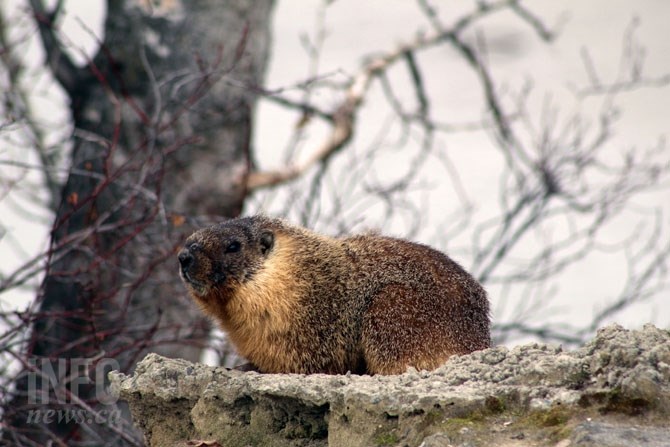
FILE PHOTO
(STAFF / iNFOnews.ca)
September 25, 2018 - 6:30 PM
Whether it's a summertime stroll through McArthur Island Park or walking around Vernon's Kal Tire Place, you're sure to see a few marmots along the way.
There are several different types of marmots, but if you spot them in the Thompson-Okanagan, they're most likely to be yellow-bellied marmots. Provincial coordinator for WildSafe B.C., Frank Ritcey, compares them to "ground squirrels on steroids."
"They’re a rodent, they eat vegetation," Ritcey says. "They do go into hibernation quite early."
If you take a look at the places in your area where marmots frequent, like Twin Lakes Golf Course in Kaleden, at this time of year, you'll be hard pressed to find one. Ritcey says that's because marmots head for their winter sleep usually by mid-August, and they don't come out until roughly April depending on the weather.
Marmots feed off of grass, dandelions and all different types of vegetation, which makes parks so attractive for them. But urban areas are also suitable for the creatures, so long as they can find shelter, Ritcey says.
"They seem to do very well in urban areas," he says. "One thing the marmot needs is suitable shelter, a place where it can burrow into the ground, usually rocky soil so predators can't dig them out. That’s what makes them such a challenge."
Those predators can include coyotes, bears and hawks, Ritcey says, adding that the marmot's biggest predator is a badger because they can dig the marmot out of its burrow.
As far as what these animals add to the ecosystem, Ritcey says marmots are extremely important for animals higher up the food chain. They take vegetation and convert it into protein, which the higher level predators feed on.
Marmots may look cute, but they're pesky to get rid of.
"Instead of trying to remove the animal what you need to do is remove a couple of things they need," Ritcey says, explaining that food and shelter being taken away will help reduce the rodent's population. "Getting rid of the food can be a real challenge. In the case of McArthur Island, one of the big problems is people feeding the animals. It's really important that people not feed wildlife of any type. If you can take away that feeding, then the other thing you should take away is their areas to burrow. It’s a challenge but if you use wider fencing you can exclude them from areas they have been using."
If they don't have a safe place to den, they'll move on, Ritcey says. But because certain areas across the region already have an established population it makes it even more difficult to get rid of them. Ritcey reiterates the biggest factor in reducing the population is for people to stop feeding them.
To learn more about interacting with wildlife, go to WildSafe B.C.'s website.
To contact a reporter for this story, email Ashley Legassic or email the editor. You can also submit photos, videos or news tips to the newsroom and be entered to win a monthly prize draw.
We welcome your comments and opinions on our stories but play nice. We won't censor or delete comments unless they contain off-topic statements or links, unnecessary vulgarity, false facts, spam or obviously fake profiles. If you have any concerns about what you see in comments, email the editor in the link above.
News from © iNFOnews, 2018